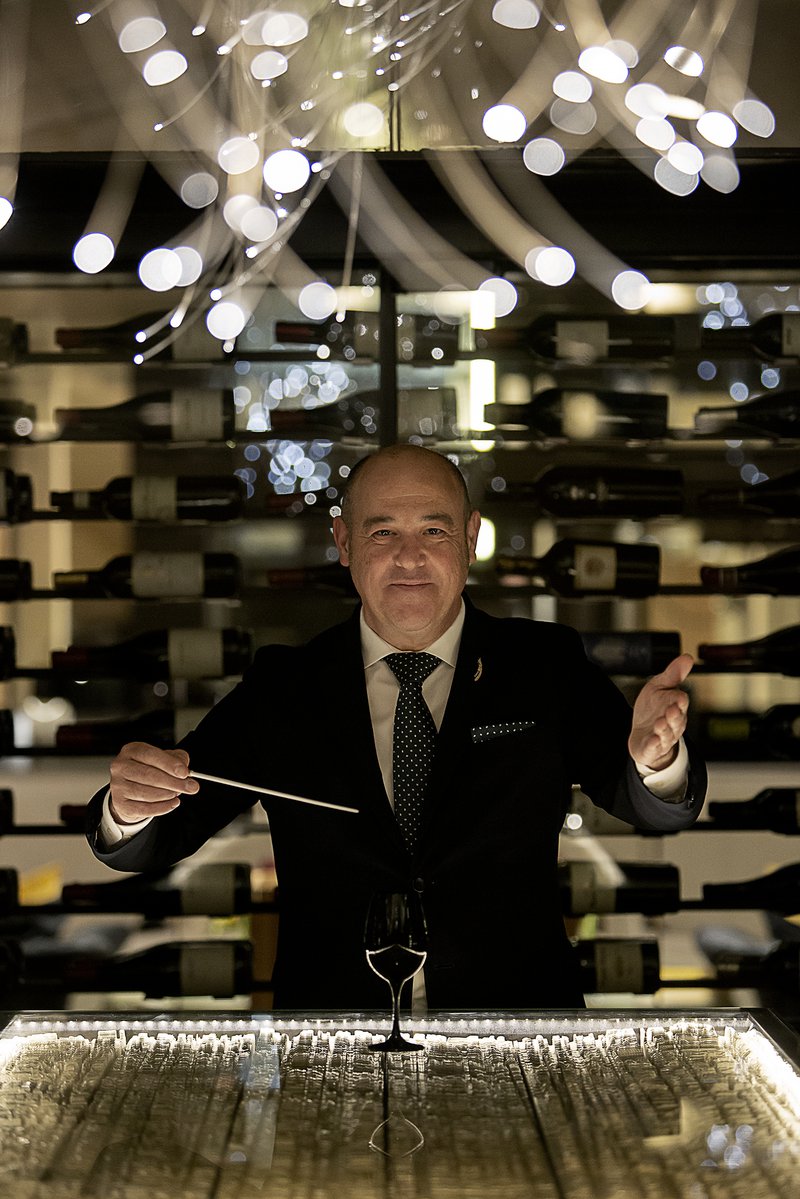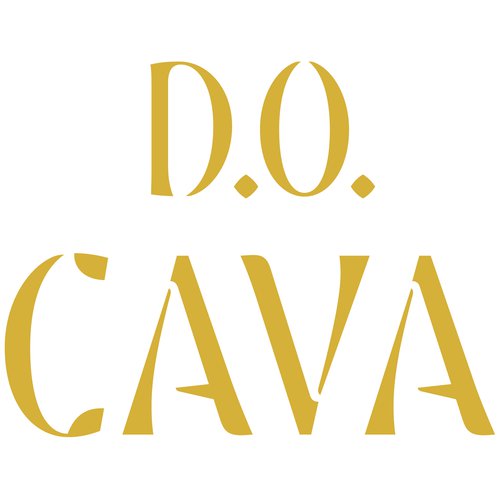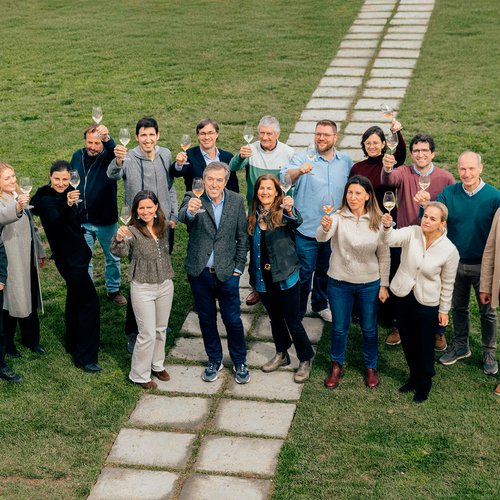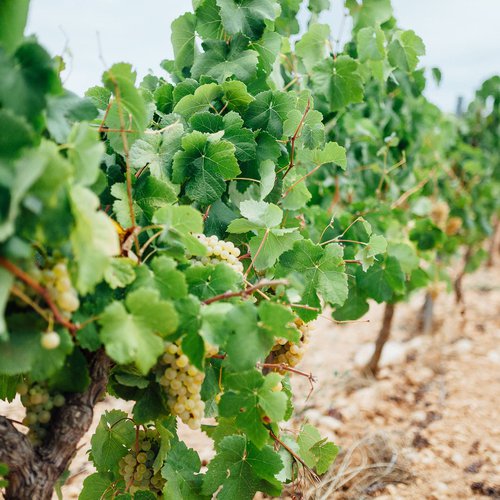Cava Dialogues with Juan Carlos Ibáñez, sommelier and maître d'hôtel at Lasarte.
Lasarte’s is probably one of the most harmonious and elegant wine lists that a customer could ever hold in their hands. Beautifully sewn with thread, it’s a book where each and every page is full of liquid passion, where the value lies in the names of people and landscapes. It begins with the sparkling wines, and the first lines are devoted to the DO Cava for its historical value and the way it’s take root in the heart of the Comtats de Barcelona.
The sommelier who created it is Juan Carlos Ibáñez, calm, discreet, talented and trained in the very best restaurants. He understands that it’s the customer who’s at the centre of the gastronomic experience, as he learnt years ago under the guidance of Santi Santamaria at Can Fabes. Ibáñez is a sommelier who speaks of pleasure, harmony, discretion and balance, and does so with great elegance and simplicity. The hustle and bustle and the pressures of everyday life in a three Michelin-starred restaurant are a world away from the serenity of the Montseny, where he lives and writes, when he feels inspired. He’s currently working on a book with a title that is effectively a play on words, and has two meanings A quién le sirva [‘servir’ as ‘serve’ in the sense of serving wine, and also meaning ‘to be useful’], but is taking his time, and in no hurry to get it finished. It will not only contain technical and educational material, the result of many years of experience in the restaurant sector, but also a story forged in passion and the emotions. He knows how to delve into the depths of wine, and add poetry.

How important is the wine list in a restaurant?
It’s fundamental. I’m very much in favour of the customer holding it in their hands and fully exploring it. The way it looks is important, but so is how it feels to the touch. It’s the sommelier's job to assess and recommend. We don’t want to impose, in fact quite the opposite. The wine list speaks for itself, as does the table linen, the glasses, the crockery - everything must be in harmony in a restaurant like ours.
How did the one at Lasarte come into being?
Lasarte now has over 20 years of history behind it. I started out in Can Fabes, the first restaurant in Catalonia to receive three Michelin stars. This means that there are people from all over the world who look at you, who value you - and you have to give the very best of yourself. I've tasted a great many wines over the course of my life, and the wine list is a synthesis of this personal and professional journey, a journey that required extreme care, because someone has invested money in the business.
Ensuring that it can please people from radically different cultures is a huge challenge.
You need to include landscapes from all over the world, but you have to make a very careful selection from each area, based on what you think is good for your cuisine. A lot of very personal research is involved; searching for small wineries producing truly extraordinary wines, not simply accepting what the market wants to give you. We don’t aim to surprise with the wines we offer, what we’re looking for is the pleasure of that precise moment, suggesting wines and sparkling wines that suit the dish, and above all that create harmonies with the person. And the more you know about that person, the more precise the pairing will be. You must never put your professional opinion before the diner’s tastes and needs. The aim is to understand the customer so that you can make their experience both enjoyable and extraordinary.
What role does Cava play in a restaurant where diners also request Champagne?
We’re in Cava country, and we need to champion what we produce. It’s a hugely important drink in terms of our history and culture, and should stand proud on our tables - and not just be drunk at parties and celebrations. It has a low alcohol content, it’s light and delicate and well able to share the stage with any cuisine in the world. On the wine list, I like to include the name of the producer, the town and the plot. This is a sure way to enhance its value.
How have the Cavas on Lasarte’s wine list been chosen?
I’ve always been a champion of Cava, searching for producers who’ve delivered high quality over the years and have shown a process of evolution, from parents down to children and grandchildren. We’ve known them for a very long time, and we’ve grown together at the same pace. Like us, they seek quality and excellence, we know that they put love into everything they do, and so they uphold the weight of those three Michelin stars just as we do. We’ve followed the trajectory of the world of Cava, and seen how it has steadily been gaining ground internationally. It’s extremely important to us here in Catalonia, and also abroad. It needs to be there on every table once again so that the younger generations can try it and really get to know it. We need to add value to the good things we have.
How do you promote Cava in the restaurant?
We’re the first to recommend it. We serve a glass of Cava with the aperitifs. In terms of quality we’re very selective, and we offer Cavas from producers we really trust. A sommelier must be able to recommend Cava, a drink in its own right, and we have to keep on pushing it, never giving up - because Champagne sells itself.
And how do you see things within the DO today?
I’m steadily finding higher quality and more plots, and a very precise, respectful winemaking culture. There’s been a commitment to ageing the Cava for longer, and the years add so much to the taste. The Guarda Superior Cavas are full of incredible surprises. But the younger ones are also valued; here we’re looking for taste and dynamism in the mouth, a wine that’s easy to drink and full of freshness. Sometimes you get pleasure from a Cava aged for 20 months too, it depends on the varieties, how winemaking is understood, how...
How does Cava connect with the cuisine at Lasarte?
We work a great deal with the produce of the sea; purity is important. Prawns from the Catalan coast, seafood from Galicia and northern Spain, fish from the Cantabrian sea. And there’s a fusion with Mediterranean cuisine as well. Cava brings verticality and freshness, and it goes well with saltiness. With crustaceans we opt for sparkling wines with a touch of sweetness or a rosé. Sometimes we look for those made with red grape varieties, blancs de noirs, to give balance and add a play on colour.
And how is this perceived by the customer?
Our customers are very receptive. We have diners who are used to haute cuisine. They understand the culture of gastronomy, they’re open to trying things and accepting the sommelier’s recommendations.
We’ve sometimes heard you say that bubbles are a part of your life.
That’s absolutely true, and not only at Lasarte. A roast chicken is really good, but with Cava it’s utterly delicious. You need to have an open mind. And when you’re not busy with the pressures of everyday life, you really enjoy it. The memory stays with you, and that’s what’s most important about a pairing.
How about giving us some specific recommendations?
I have a lot of Cavas in mind, and I can certainly mention a few. For example, the La Pleta de Codorníu Paraje Calificado, produced by enologist Bruno Colomer. It’s a 100% chardonnay. I’m also very fond of the Mim Natura pinot noir and chardonnay, blanc de noirs, from Vins el Cep. There are exquisite vintages so good that they raise the hairs on your arms! And there’s La Siberia, the pinot noir from Juvé & Camps. I like the tight, fine bubbles and the mousse you get in sparkling wines made with the chardonnay grape. In the varieties typically used to make Cava, you find different flavours.
What path does Juan Carlos Ibáñez think DO Cava should take in the future?
The sector lacks a sense of unity, and consumers are confused, but we need to be able to establish Cava as the important drink that it really is. For me a soil study is essential, as is creating a Cru system like those of France and Germany. Being more plot-based, taking great care of every detail.
And finally, what role does the sommelier play in offering the best wine?
Clearly the best wine is the one you remember. I’ve tasted and drunk - two very different things - a great many exquisite bottles, but I’d say that the service in the restaurant, the space where you drink it, and the care with which it’s served to you are factors that contribute to making a wine memorable as well. Savoir faire and discretion are key. There are so many factors that all come together. Sometimes you find what you’re looking for, and sometimes what you find astonishes you. What is very clear is that the sommelier is just one piece of the puzzle, no more, no less, and you always need to prioritise the precise moment in time and the person themselves.






